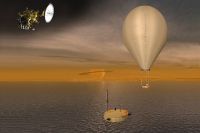 Реклама Google — средство выживания форумов :)
Реклама Google — средство выживания форумов :)
-
/pic_aae95ceb1bf766b91ca630c79fd1dbfc.jpg)
Титан
спутник СатурнаТеги:

На спутнике Сатурна нашли жизнь
Ученые НАСА заявили, что на Титане обитают примитивные организмы, которые используют для дыхания водород. По мнению исследователей, речь может идти о совершенно новой форме биологической жизни. // www.vesti.ruНа спутнике Сатурна - Титане - обнаружены признаки существования жизни, сообщает "Россия 24".
Учёные НАСА сделали такое заявление после анализа данных АМС "Кассини". По их словам, примитивные организмы дышат водородом и потребляют находящиеся на поверхности Титана химические соединения, получая тем самым необходимую энергию.
"Мы считаем, что находящийся в атмосфере Титана водород используется биологическими формами аналогично тому, как на Земле живые организмы дышат кислородом", - сказал один из исследователей Крис Маккей.
Он не исключил, что речь идет о совершенно новой форме биологической жизни, полностью отличной от земной.

NASA - What is Consuming Hydrogen and Acetylene on Titan?
Two new papers based on data from NASA's Cassini spacecraft scrutinize the complex chemical activity on the surface of Saturn's moon Titan. // www.nasa.govWhat is Consuming Hydrogen and Acetylene on Titan?
PASADENA, Calif. - Two new papers based on data from NASA's Cassini spacecraft scrutinize the complex chemical activity on the surface of Saturn's moon Titan. While non-biological chemistry offers one possible explanation, some scientists believe these chemical signatures bolster the argument for a primitive, exotic form of life or precursor to life on Titan's surface. According to one theory put forth by astrobiologists, the signatures fulfill two important conditions necessary for a hypothesized "methane-based life."
One key finding comes from a paper online now in the journal Icarus that shows hydrogen molecules flowing down through Titan's atmosphere and disappearing at the surface. Another paper online now in the Journal of Geophysical Research maps hydrocarbons on the Titan surface and finds a lack of acetylene.
...
Strobel, who studies the upper atmospheres of Saturn and Titan, analyzed data from Cassini's composite infrared spectrometer and ion and neutral mass spectrometer in his new paper. The paper describes densities of hydrogen in different parts of the atmosphere and the surface. Previous models had predicted that hydrogen molecules, a byproduct of ultraviolet sunlight breaking apart acetylene and methane molecules in the upper atmosphere, should be distributed fairly evenly throughout the atmospheric layers.
Strobel found a disparity in the hydrogen densities that lead to a flow down to the surface at a rate of about 10,000 trillion trillion hydrogen molecules per second. This is about the same rate at which the molecules escape out of the upper atmosphere.
"It's as if you have a hose and you're squirting hydrogen onto the ground, but it's disappearing," Strobel said. "I didn't expect this result, because molecular hydrogen is extremely chemically inert in the atmosphere, very light and buoyant. It should 'float' to the top of the atmosphere and escape."
Strobel said it is not likely that hydrogen is being stored in a cave or underground space on Titan. The Titan surface is also so cold that a chemical process that involved a catalyst would be needed to convert hydrogen molecules and acetylene back to methane, even though overall there would be a net release of energy. The energy barrier could be overcome if there were an unknown mineral acting as the catalyst on Titan's surface.
...
The absence of detectable acetylene on the Titan surface can very well have a non-biological explanation, said Mark Allen, principal investigator with the NASA Astrobiology Institute Titan team. Allen is based at NASA's Jet Propulsion Laboratory in Pasadena, Calif. Allen said one possibility is that sunlight or cosmic rays are transforming the acetylene in icy aerosols in the atmosphere into more complex molecules that would fall to the ground with no acetylene signature.
"Scientific conservatism suggests that a biological explanation should be the last choice after all non-biological explanations are addressed," Allen said. "We have a lot of work to do to rule out possible non-biological explanations. It is more likely that a chemical process, without biology, can explain these results - for example, reactions involving mineral catalysts."


Вот тут немного подлиннее по-русски: На Титане обнаружены новые признаки жизни
Достаточно баянистая новость.
Достаточно баянистая новость.



Lenta.ru: Прогресс: "Кассини" обнаружил исчезновение кратеров на Титане
Ученые, работающие с данными аппарата Кассини, обнаружили, что процессы ветровой эрозии приводят к быстрому сглаживанию и заполнению песком кратеров на Титане - спутнике Сатурна . Открытие было сделано на основании сравнения соотношения глубины и диаметра кратеров на Титане и спутнике Юпитера Ганимеде. // www.lenta.ru

- Balancer [29.05.2013 15:37]: Перенос сообщений из Титан

В атмосфере Титана замечен неизвестный газ
Обнаружить его раньше не удавалось из-за того, что та часть спектра, в которой он излучает, находится рядом с таковой метана. // compulenta.computerra.ru


Полет над метановыми озерами Титана: видео от NASA
Титан — один из наиболее интересных спутников Сатурна. Титану уделают достаточно много времени ученые разных стран, включая специалистов из NASA. Не так давно... // habrahabr.ru


NASA собирается отправить на Титан квадрокоптеры для сбора образцов
Титан — крупнейший спутник Сатурна. По размерам он превосходит Меркурий, правда несколько меньше него по массе. Титан окружен плотной атмосферой и является... // habrahabr.ru


Астрономы нашли в море на Титане необычный остров
Ученые впервые наблюдали геодинамические изменения на поверхности Титана, проявляющиеся в формировании образования островного типа в метановом море спутника. Исследователи склоняются к тому, что обнаружили изменения, связанные с сезонным характером климата. // lenta.ru


Азот попал на Титан из облака Оорта
Астрофизики, которые исследовали относительное содержание изотопов азота N-14 и N-15 на Титане, пришли к выводу, что оно почти такое же, как и у комет из облака Оорта. Это позволило ученым предположить, что вещество, из которого образовался Титан, ранее могло находиться в тех же условиях, что кометы из облака Оорта. // lenta.ru


Ученые предположили существование жизни на спутнике Сатурна
Ученые из Корнелльского университета обосновали возможность существования альтернативной формы жизни на Титане, спутнике Сатурна. // style.rbc.ruАмериканские химики и физики из Корнелльского университета доказали, что в метановых морях Титана могут существовать способные к размножению, передвижению и обмену веществ клетки, которым для этих процессов не нужны ни вода, ни кислород. Об этом сообщается на сайте университета.
Зарождение и развитие жизни на Земле было бы невозможным без фосфолипидов: эти вещества образуют водонепроницаемые мембраны, защищающие клетки от внешних факторов. Пузырь из фосфолипидов называется липосомой. Поскольку фосфолипиды состоят из воды, астрономы обычно исключают планеты с низкими температурами на поверхности из списка гипотетически обитаемых. Но если предположить, что клетки организма состоят не из воды, а из метана, температура замерзания которого гораздо ниже, жизнь может существовать даже в считающихся в традиционной биологии непригодных для этого условиях. Например, на Титане.
Именно от этой идеи отталкивались ученые. Они назвали такую построенную на метане модель мембраны азотосомой. Она состоит из молекул азота, углерода и водорода, существующих в морях Титана.
С помощью метода молекулярной динамики ученые вычислили соединение, которое с наибольшей вероятностью может самостоятельно «собраться» в органическую мембрану в данных условиях. Им стал акрилонитрил. Он прочен, практически не распадается и не мене гибок, чем фосфолипидные мембраны на Земле. И он есть в атмосфере Титана.


 Реклама Google — средство выживания форумов :)
Реклама Google — средство выживания форумов :)
- Последние действия над темой
- Balancer [29.05.2013 15:37]: Перенос сообщений из Титан
- Все действия над темой
Copyright © Balancer 1997..2018
Создано 02.11.2010
Связь с владельцами и администрацией сайта: anonisimov@gmail.com, rwasp1957@yandex.ru и admin@balancer.ru.
Создано 02.11.2010
Связь с владельцами и администрацией сайта: anonisimov@gmail.com, rwasp1957@yandex.ru и admin@balancer.ru.
 Fakir
Fakir

 инфо
инфо инструменты
инструменты Naturalist
Naturalist

 Balancer
Balancer

 Balancer
Balancer
